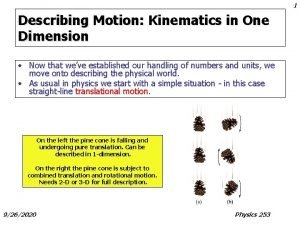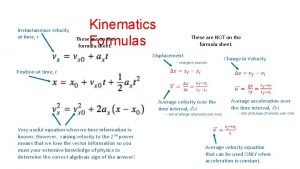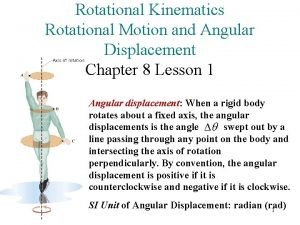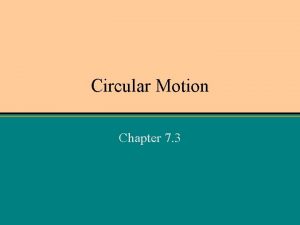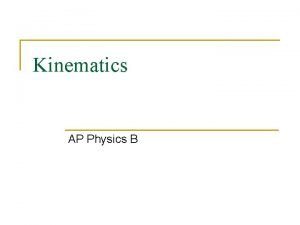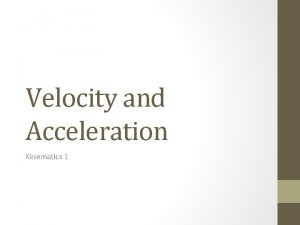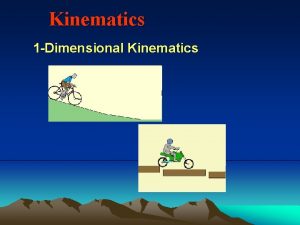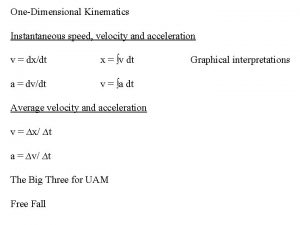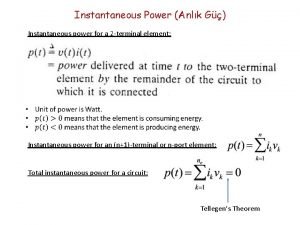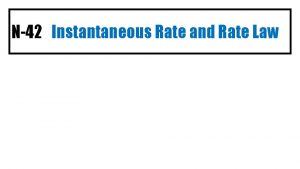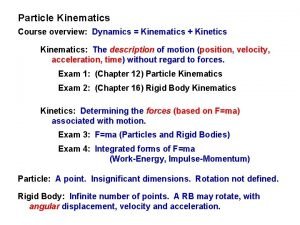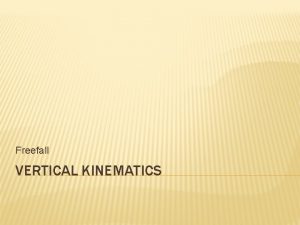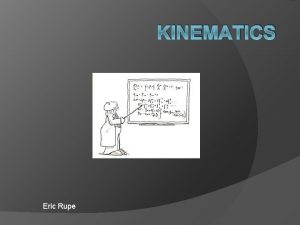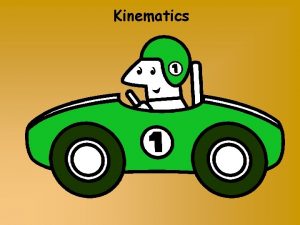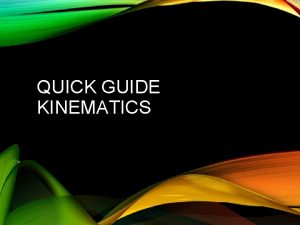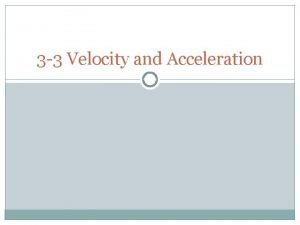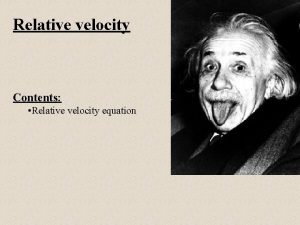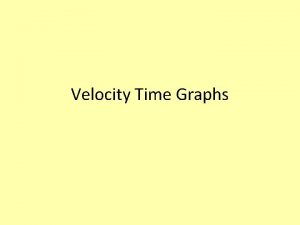Kinematics Formulas Instantaneous velocity at time t These

















- Slides: 17

Kinematics Formulas Instantaneous velocity at time, t These are on the formula sheet. These are NOT on the formula sheet. Displacement - change in position Position at time, t Change in Velocity Average velocity over the time interval, △t - rate of change of position over time Average acceleration over the time interval, △t - rate of change of velocity over time Very useful equation when no time information is known; However, raising velocity to the 2 nd power means that we lose the vector information so you must your extensive knowledge of physics to determine the correct algebraic sign of the answer! Average velocity equation that can be used ONLY when acceleration is constant.

Study of Motion Changing position Since Physics is the study of physical phenomena, it makes sense to begin by understanding where an object is located and how it moves. We will develop a basic understanding of motion - the location of objects and how their location may change. Initial The study of motion without regard for the cause of motion is called Kinematics. Our study of motion will begin with linear motion – objects moving back and forth along a line. The location of an object is called its position. To locate an object, a ‘Frame of Reference’ is required. A number line is a reasonable ‘Frame of Reference’ for linear motion. A B Final Miles When objects move, our notation needs to reflect the change in position. For the car shown above, the initial (starting) position is 0 and the final (ending) position is 10 miles. C meters On the number line above, Car A’s position is -5 meters while Car B’s position is -1 meters and Car C’s position is +5 meters. Position is based on the location of the front bumper. Line 1 The correct notation for the position of each car is shown above. The variable for position is an ‘x’. The unit is ‘m’ for meters based on the label along the number line. The subscript on the ‘x’ variable identifies the car. Relative Position Line 1 The positions in describe the cars’ positions relative to the number line. It is also possible to describe the cars’ positions relative to one another. Relative to Car A: Car B’s position is more positive (even though its position is negative). Car C’s position is more positive than A’s. The distance from Car A to Car B is 4 meters in the positive direction even though the positions of Cars A and B are negative. . The notation for the car’s initial and final positions makes it clear that the car started at 0 and ended 10 miles away. Displacement is the change in position of an object. Displacement is represented by the variable ‘Δx ‘. The triangular shape ‘Δ’ is the greek letter, delta. In science and math, ‘Δ’ means ‘change ‘. Mathematically, we find a change, or a difference, by subtraction. So, Displacement is calculated by subtracting the initial position from the final position: The displacement of the car above is: 18

Motion Diagrams A motion diagram is a combination of dots and arrows that shows motion in equal time intervals. Although motion diagrams can be quantitative, we will use them as qualitative tools. Motion diagrams are a helpful way to visualize changing position and relate changing position to graphs. By putting together the elements described at the left, a simple motion diagram is shown below: The elements of a motion diagram include: - An axis that serves as frame of reference. This motion diagram shows an object that begins at 0, then moves in the positive direction at a constant velocity over three equal time intervals. A minimum of three time intervals is needed to show constant velocity. - 0 +x Dots to show position at equal time intervals. Starting position and arrows to show direction of motion. Object starts at 0; moves in the positive direction for 3 time intervals; stops for three time intervals. start 0 +x Motion diagrams must align with the motion path. A motion diagrams for an object moving up and down would be vertical. For an object rolling down hill, the motion diagram would slant downward in the direction of motion. Object starts at the base of an incline at 0; moves up the hill in the positive direction in one time interval; stops for a ‘long’ time. Object starts in a positive position; moves in the negative direction over four time intervals. The final position is negative. start 0 +x start +x 0 start 0 +x 19

Motion Diagram Example A Word Description start A. Positive constant velocity with an initial position at 0. 0 +x start B. Starting at a positive position, slowing down, accelerating in the opposite direction of motion. B 0 +x start C C. Starting at a positive position, getting faster, accelerating in the same direction as motion. 0 +x start D 0 +x D. Starting at a positive position, moving at a constant negative velocity for 3 time intervals, then accelerates in the opposite direction of motion to slow down to stop before reaching 0. 20

Motion Diagrams and Graphs. Motion diagrams can be easily turned into graphs. Each dot on a motion diagram shows the position of the object at equal time intervals. If the motion diagram is placed parallel to the position axis, the dots can simply be moved to the graph and placed at equal time increments. Similarly, graphs can be converted to motion diagrams. Motion begins at ‘ 0’ and moves in the positive direction at a constant speed for three time increments. Next, object remains at rest for two time increments. Time increments are 2 units long. Motion begins away from zero in a positive position. Object moves at a constant speed in the positive direction over two increments. Next, object changes direction to move FASTER in the negative direction over two time increments. Next, the object remains in the same location for one time increment. Time increments are 2 units long. Motion begins away from zero in a positive position. Object moves at a decreasing speed over three increments. Time increments are 4 units long. 21

Graphing changing position Graphing the position of objects is central to our study of Physics. The data table shows the position of an object over a 10 second period. The initial time and position are: Time (sec) Position (meters) 0 5 1 11 3 20 4 27 6 35 9 47 10 50 The final time and position are: Interpreting a Position vs. time graph x x vs. t C B t Time is graphed on the horizontal axis. Position is graphed on the vertical axis. The ordered pairs will be ( t , x ). The first value in the ordered pair (t) will indicate the distance moved along the horizontal, or t, axis. The next value (x) will be graphed along the vertical, or x, axis. The data is represented graphical on the Position vs. time (x vs. t) graph. A The Position vs. time graph above shows the changing position over time of three objects: A, B and C. This graph does not show their paths. In other words, A is not going downhill and B is not going uphill. The motion diagram below shows the paths of their motions: Object C is stationary in a positive position. Object B begins in a negative position and moves in the positive direction. Object A begins in a positive position and moves in the negative direction. A has the longest displacement, B has a small displacement, while C has no displacement. 22

What can we learn from motion graphs? The rate of change of an object’s position tells us a great deal about its motion. The shape of a Position vs. time graph can tell us whether an object is • at rest (sitting still) • moving at a steady speed • getting faster or slower • changing directions The changing position of an object over time informs us about two key dimensions of kinematics: Velocity v Acceleration a Although we begin with the x vs. t graph, velocity and acceleration graphs will be part of our study as well. The x, v and a graphs on the left depict the same motion. We begin our study with x vs. t graph to help us better understand the v vs. t and a vs. t graphs, too. Finding slope from an x vs. t graph x x vs. t R t P The the slope l x v ine on of s. t an rev graph vel eals oci ty. The slope of a line on an x vs. t graph reveals the speed and the direction of motion. In physics, the term “velocity” means speed in a certain direction. Really Big Idea The graph above is a qualitative graph since no numbers are included along the axis. Even though this is a simple graph without numbers we can conclude the following: R and P begin at the same location. R and P begin moving at the same time. R’s velocity is positive. P’s velocity is negative. R and P move in opposite directions. er steep s i R moves faster than P. u tell? ? Rt R goes a f o unt o can y ing th How n P show ame amo tha he s r in t e as P. e h t r fa tim 23

Finding Displacement and Velocity The graphs of R and P show that they are moving at a steady pace in opposite directions. This is called motion at constant velocity or uniform motion. Uniform motion: An object that is displaying uniform motion will move equal distance in equal time intervals. The Displacement can be found with the displacement formula: For R: Xi = 0 m Xf = 8 m For P: Xi = 0 m Xf = -2 m The Velocity can be found by finding the slope of the line on the x vs. t graph. (Instructions for finding velocity on pages 25 and 33) 24

Velocity is the rate of change of position over time. Velocity is more descriptive than speed because velocity includes the direction of motion. On an x vs. t graph, the slope of the line is the average velocity. The algebraic sign for velocity indicates the direction of motion. A object with positive velocity will move in the opposite direction than an object with negative velocity. Distance, Displacement, Speed and Velocity Distance: - Dashed line - Is path dependent - Does not specify direction - Is a scalar - Is always positive - Can include changes in direction Average Velocity Displacement: - Solid line - Is not path dependent - Length of straight line from start to end - Specifies direction - Is a vector - Δx = xf - xi - can be positive or negative - (+) or (-) sign indicates direction - rate of change of position over time. Δx - is the average velocity over a time interval. - is relative to a reference point. - includes direction. - is based on displacement. Instantaneous Velocity - velocity at a particular time (instant). - is relative to a reference point. - includes direction. Animation at this site: NOTE: THIS ANIMATION IS LABELED ‘SPEED’ SIMPLY BECAUSE DIRECTIONS ARE NOT SPECIFIED. http: //www. physicsclassroom. com/mmedia/kinema/trip. cfm Speed: - Does not specify direction - Is a scalar - Is based on distance - Is always positive - Speed = distance / time - s = d/t Average Velocity: - Specifies direction - Is a vector - Is based on displacement - Can be positive or negative - V = Δx / Δt - (+) or (-) sign indicates direction 25

When velocity is constant v v vs. t B + 0 _ C t A The graph above shows three objects at three different velocities. C has a velocity of zero. The graph indicates that C is not changing position (it has stopped). B is moving with a positive velocity that is constant. A is moving with a negative velocity that is constant. B and A are moving in opposite directions. Velocity vs. time graphs reveal how far an object moves in a certain period of time. However, v vs. t graphs do not reveal the object’s actual position – only how much position has changed. For the graph below, the object is moving at two different constant velocities. It obviously cannot have two different velocities at the same time, so the velocities occur over separate time intervals. This object moves in opposite directions during each time interval. v vs. t V(m/s) 6 0 - 3 Δx. I = 4 s * - 3 m/s = - 12 m Δx. II 3 Δx. I 4 10 t(s) Δx. II = 6 s * 6 m/s = 36 m The total displacement over the first 10 seconds is Δx I + Δx. II = 24 m 26

ne i l the h f o e rap n. p g o t l s tio s. The a v v celera v on ls ac a e rev When velocity is v vs. t F D t E The Velocity vs. time graph above shows three objects with CHANGING velocities. F begins with a velocity of 0 and gets faster at a steady pace. From this information, we know the object is moving in the positive direction but we cannot determine the position. E and D change directions E begins with a large positive velocity then slows to a stop before changing directions. Next, E begins to speed up in the negative direction. NOT constant Velocity vs. time graphs reveal how far an object moves in a certain period of time. However, v vs. t graphs do not reveal the object’s position – only how much position has changed. For the graph below, the object is begins moving one direction before slowing to a stop and turning around. The displacement in interval II is negative. V(m/s) v vs. t Δx. I = ( ½ ) 4 s * 8 m/s = 16 m 8 4 0 - 4 Δx. II 4 6 Δx. II t(s) Δx. II = (½) 2 s * - 4 m/s = -4 m The total displacement over the first 10 seconds is Δx I + Δx. II = 12 m 27

Finding Displacement, Velocity and This set of graphs show different dimensions (displacement, velocity and Acceleration acceleration ) of the SAME moving object. The object is moving with constant acceleration after starting from rest (stopped). The graph at the bottom left is the Acceleration vs. time graph. It shows a steady acceleration of 1 m/s 2 over 4 seconds. The center graph shows how the velocity changes at a steady pace. At the start (t=0 s), the velocity is 0. The velocity increases by 1 m/s every second, so after 4 seconds velocity is 4 m/s. Acceleration is the slope of the line on the Velocity vs. time graph. The graph at the top is the Position vs. time graph. The displacement can be found by determining the area ‘under the curve’ on the Velocity vs. time graph, or with the displacement formula: Velocity is the slope of the line on the x vs. t graph. For the x vs. t graph at the upper right, velocity is changing so the INSTANTANEOUS velocity can be found by finding the slope of the line tangent to the curve. (Instructions for finding velocity on pages 25 and 33) 28

Acceleration When an object accelerates, its velocity changes. In Physics, acceleration can mean getting faster, getting slower or changing directions. The term ‘decelerating’ is seldom used in Physics. When acceleration is in the same direction as motion, velocity increases. GETS FASTER Acceleration is - rate of change of velocity over time. - is a vector. When acceleration is in the opposite direction as motion, velocity decreases. Δv GETS SLOWER - specifies direction. - is based on velocity. - S. I. units: m/s/s or m/s 2 - means getting faster, getting slower or changing directions. When acceleration is perpendicular to the direction as motion, the object follows a curving path. . GOES IN A CIRCLE 29

Information on Motion graphs when acceleration is constant x vs. t graphs A horizontal (flat) line on a Position vs. time graph indicates velocity is zero. x C x vs. t t A slanted line on a Position vs. time graph indicates constant velocity. A curved line (parabola) on a Position vs. time graph indicates constant acceleration. v C a vs. t graphs a a vs. t The slope of the line on a velocity vs. time graph reveals acceleration. D v vs. t A slanted line on an velocity vs. time graph reveals constant acceleration. t t A horizontal line on an acceleration vs. time graph reveals constant acceleration. A steeper line on a velocity vs. time graph means greater acceleration. The area under the curve on a velocity vs. time graph reveals the change in position (displacement). D C A horizontal (flat)tline on a velocity vs. time v vs. graphs graph indicates acceleration is zero. When a slanted line on a velocity vs. time graph crosses over the time axis, the object has stopped and changed directions. D The area under the curve on an acceleration vs. time graph reveals the change in velocity. Be sure to review the basics about u Calculating the area under the curve on page 26. u. Calculating the slope of the line on 30

Instantaneous velocity The x vs. t graphs below show an object that is accelerating. The curved shape of the graph indicates acceleration. When an object accelerates, its velocity changes. If a line is placed tangent to the curve on the x vs. t graph, the slope of the line reveals the instantaneous velocity of the of object. 31

When the x vs. t graph smiles: When the x vs. t graph smiles The slope of the line on the v vs. t graph is positive. The acceleration is constant and positive. SMILES are POSITIVE. When the x vs. t graph frowns: When the x vs. t graph frowns The slope of the line on the v vs. t graph is negative. The acceleration is constant and negative. FROWNS are NEGATIVE. 32

Kinematic Equations Motion equations for constant acceleration Displacement: Change in position Change in velocity Average Velocity acceleration Average Motion equation for constant velocity Where : Where Xf is the final position Xi is the initial position v is the average velocity over the time interval t is the duration of the time interval. Xf is the final position Xi is the initial position vf is the final velocity vi is the initial velocity v is the average velocity over the time interval a is the average acceleration over the time interval. t is the duration of the time interval. 33
 Instantaneous velocity vs average velocity
Instantaneous velocity vs average velocity Aplusphysics kinematics-horizontal kinematics
Aplusphysics kinematics-horizontal kinematics Instantaneous velocity
Instantaneous velocity Instantaneous velocity
Instantaneous velocity How to find velocity in physics
How to find velocity in physics Angular velocity units
Angular velocity units Instantaneous velocity circular motion
Instantaneous velocity circular motion Is v final velocity
Is v final velocity Deceleration formula
Deceleration formula Robot planar
Robot planar 2d motion equations
2d motion equations Acceleration definition
Acceleration definition Darcy's law hydraulic conductivity
Darcy's law hydraulic conductivity Angular acceleration and linear acceleration
Angular acceleration and linear acceleration Initial velocity and final velocity formula
Initial velocity and final velocity formula Derivation of darcy's law
Derivation of darcy's law Angular velocity to tangential velocity
Angular velocity to tangential velocity Minimum speed for vertical circular motion
Minimum speed for vertical circular motion
